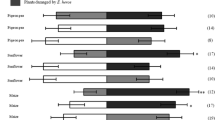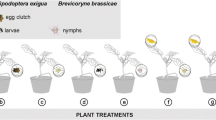Abstract
Chelonus insularis (Hymenoptera: Braconidae) is an egg-larval endoparasitoid that attacks several lepidopteran species, including the fall armyworm (FAW), Spodoptera frugiperda, as one of its main hosts. In this study, we identified the volatiles emitted by maize plants undamaged and damaged by S. frugiperda larvae that were attractive to virgin C. insularis females. In a Y-glass tube olfactometer, parasitoid females were more attracted to activated charcoal extracts than Porapak Q maize extracts. Chemical analysis of activated charcoal extracts from maize plants damaged by S. frugiperda larvae by gas chromatography coupled with electroantennography (GC-EAD) showed that the antennae of virgin female wasps consistently responded to three compounds, identified by gas chromatography-mass spectrometry (GC-MS) as α-pinene, α-longipinene and α-copaene. These compounds are constitutively released by maize plants but induction via herbivory affects their emissions. α-Longipinene and α-copaene were more abundant in damaged maize plants than in healthy ones, whereas α-pinene was produced in higher amounts in healthy maize plants than in damaged ones. Female parasitoids were not attracted to EAD-active compounds when evaluated singly; however, they were attracted to the binary blend α-pinene + α-copaene, which was the most attractive blend, even more attractive than the tertiary blend (α-pinene + α-longipinene + α-copaene) and the damaged maize plant extracts. We conclude that C. insularis is attracted to a blend of herbivore-induced volatiles emitted by maize plants.






Similar content being viewed by others
References
Arn H, Standler E, Rauscher S (1975) The electroantenographic detector. A selective and sensitive tool in the gas chromatographic analysis of insect pheromones. Z Naturforsch 30c:722–725
Bernasconi ML, Turlings TCJ, Ambrosetti L, Bassetti P, Dorn S (1998) Herbivore-induced emissions of maize volatiles repel the corn leaf aphid, Rhopalosiphum maidis. Entomol Exp Appl 87:133–142
Beyaert I, Wäschke N, Scholz A, Varama M, Reinecke A, Hilker M (2010) Relevance of resource-indicating key volatiles and habitat odour for insect orientation. Anim Behav 79:1077–1086
Blanco CA, Portilla M, Jurat-Fuentes JL, Sanchez JF, Viteri D, Vega-Aquino P, Teran-Vargas AP, Azuara-Dominguez A, Lopez JD, Arias RS (2010) Susceptibility of isofamilies of Spodoptera frugiperda (Lepidoptera: Noctuidae) to Cry1Ac and Cry1Fa proteins of Bacillus thuringiensis. Southwest Entomol 35:409–415
Boo KS, Yang JP (1998) Olfactory response of Trichogramma chilonis to Capsicum annum. J Asia Pac Entomol 1:123–129
Bruce TJA, Pickett JA (2011) Perception of plant volatile blends by herbivorous insects-finding the right mix. Phytochemistry 72:1605–1611
Bruce TJA, Wadhams LJ, Woodcock CM (2005) Insect host location: a volatile situation. Trends Plant Sci 10:269–274
Bukovinszky T, Gols R, Posthumus MA, Vet LEM, Van Lenteren JC (2005) Variation in plant volatiles and attraction of the parasitoid Diadegma semiclausum (Hellen). J Chem Ecol 31:460–477
Byrne KJ, Gore WE, Pearce GT, Silverstein RM (1975) Porapak-Q collection of airborne organic compounds serving as models for insect pheromones. J Chem Ecol 1:1–7
Chen YH, Gols R, Stratton CA, Brevik KA, Benrey B (2015) Complex tritrophic interactions in response to crop domestication: predictions from the wild. Entomol Exp Appl 157:40–59
Christensen SA, Nemchenko A, Borrego E, Murray J, Sobhy IS, Bosak L, DeBlasio S, Erb M, Robert CAM, Vaughn KA, Herrfurth C, Tumlinson J, Feussner I, Jackson D, Turlings TCJ, Engelberth J, Nansen C, Meeley R, Kolomiets MV (2013) The maize lipoxygenase, ZmLOX10, mediates green leaf volatile, jasmonate and herbivore-induced plant volatile production for defense against insect attack. Plant J 74:59–73
Clavijo McCormick A, Unsicker SB, Gershenzon J (2012) The specificity of herbivore-induced plant volatiles in attracting herbivore enemies. Trends Plant Sci 17:303–310
Coapio G, Cruz-Lopez L, Guerenstein P, Malo EA, Rojas JC (2016) Herbivore damaged a prior egg deposition on host plants influence de oviposition of the generalist moth Trichoplusia ni (Lepidoptera: Noctuidae). J Econ Entomol 109:2364–2372
D’Alessandro M, Turlings TCJ (2005) In situ modification of herbivore-induced plant odors: a novel approach to study the attractiveness of volatile organic compounds to parasitic wasps. Chem Senses 30:739–753
D’Alessandro M, Turlings TCJ (2006) Advances and challenges in the identification of volatiles that mediate interactions among plants and arthropods. Analyst 131:24–32
D’Alessandro M, Brunner V, von Mérey G, Turlings TCJ (2009) Strong attraction of the parasitoid Cotesia marginiventris towards minor volatile compounds of maize. J Chem Ecol 35:999–1008
Degen T, Dillman C, Marion-Poll F, Turlings TCJ (2004) High genetic variability of herbivore-induced volatile emission within a broad range of maize inbred lines. Plant Physiol 135:1928–1938
Dettmer K, Engewald W (2002) Adsorbent materials commonly used in air analysis for adsorptive enrichment and thermal desorption of volatile organic compounds. Anal Bioanal Chem 373:490–500
Fatouros NE, Dicke M, Mumm R, Meiners T, Hilker M (2008) Foraging behavior of egg parasitoids exploiting chemical information. Behav Ecol 19:677–689
Fatouros NE, Lucas-Barbosa D, Weldegergis BT, Pashalido FG, van Loon JJA, Dicke M, Harvey JA, Gols R, Huigens ME (2012) Plant volatiles induced by herbivore egg deposition affect insects of different trophic levels. PLoS ONE 7:e43607. https://doi.org/10.1371/journal.pone.0043607
Gouinguené SP, Turlings TCJ (2002) The effects of abiotic factors on induced volatile emission in corn plants. Plant Physiol 129:1296–1307
Huddleston T, Walker AK (1994) A revision of the Chelonus scrobiculatus species-group of Cheloninae (Insecta: Hymenoptera: Braconidae). Ann Naturhist Mus Wien 96:153–168
Köllner TG, Held M, Lenk C, Hiltpold I, Turlings TCJ, Gershenzon J, Degenhardt J (2008) A maize (E)-β-caryophyllene synthase implicated in indirect defence response against herbivores is not expressed in most American maize varieties. Plant Cell 20:482–494
Leppik E, Tammaru T, Frérot B (2014) A view of diel variation of maize odorscape. Am J Plant Sci 5:811–820
Lou Y, Ma B, Cheng J (2005) Attraction of the parasitoid Anagrus nilaparvatae to rice volatiles induced by the rice brown plant hopper Nilaparvata lugens. J Chem Ecol 31:2357–2372
Loughrin JH, Manukian A, Heath RR, Tumlinson JH (1995) Volatiles emitted by different cotton varieties damaged by feeding beet armyworm larvae. J Chem Ecol 21:1217–1222
Malo EA, Cruz-López L, Castrejón VR, Rojas JC (2004) Antennal sensilla and electrophysiological response of male and female Spodoptera frugiperda (Lepidoptera: Noctuidae) to conspecific sex pheromone and plant odors. Ann Entomol Soc Am 97:1273–1284
Meiners T, Hilker M (2000) Induction of plant synomones by oviposition of a phytophagous insect. J Chem Ecol 26:221–232
Molnár BP, Tóth Z, Fejes-Tóth A, Dekker T, Kárpáti Z (2015) Electrophysiologically active maize volatiles attract gravid female european corn borer, Ostrinia nubilalis. J Chem Ecol 41:997–1005
Morawo T, Fadamiro H (2014) Attraction of two larval parasitoids with varying degree of host specificity to single components and a binary mixture of host-related plant volatiles. Chemoecology 24:127–135
Morawo T, Fadamiro H (2016) Identification of key plant-associated volatiles emitted by Heliothes virescens larvae that attract the parasitoid, Microplitis croceipes: implications for parasitoid perception of odor blends. J Chem Ecol 42:1112–1121
Neveu N, Grandgirard J, Nenon JP, Cortesero AM (2002) Systemic release of herbivore-induced plant volatiles by turnips infested by concealed root-feeding larvae Delia radicum L. J Chem Ecol 28:1717–1731
Ngi-Song AJ, Njagi PGN, Torto B, Overholt WA (2000) Identification of behaviourally active components from maize volatiles for the stemborer parasitoid Cotesia flavipes Cameron (Hymenoptera: Braconidae). Insect Sci Appl 20:181–189
Nordlund DA, Chalfant RB, Lewis WJ (1985) Response of Trichogramma pretiosum females to volatile synomones from tomato plants. J Entomol Sci 20:372–376
Ortiz-Carreón FR (2015) Respuestas de Chelonus insularis Cresson (Hymenoptera: Braconidae) a volátiles de plantas de maíz (Zea mays L.). Tesis de Licenciatura. Instituto Tecnológico de Tapachula, Chiapas. México. 40 p
Paré PW, Tumlinson JH (1997) De novo biosynthesis of volatiles induced by insect herbivore in cotton plants. Plant Physiol 114:1161–1167
Paré PW, Tumlinson JH (1999) Plant volatiles as a defense against insect herbivores. Plant Physiol 121:325–331
Peñaflor MF, Erb M, Miranda LA, Werneburg AG, Bento JMS (2011a) Herbivore-induced plant volatiles can serve as host location. J Chem Ecol 37:1304–1313
Peñaflor MF, Erb M, Aurélie MR, Miranda LA, Werneburg A, Dossi FC, Turlings TCJ, Bento JM (2011b) Oviposition by a moth suppresses constitutive and herbivore-induced plant volatiles in maize. Planta 234:207–215
Rasmann S, Kollner T, Degenhardt J, Hiltpold I, Toepfer S, Kuhlmann U, Gershenzon J, Turlings TCJ (2005) Recruitment of entomopathogenic nematodes by insect-damaged maize roots. Nature 434:732–737
Reddy GVP, Holopainen JK, Guerrero A (2002) Olfactory response of Plutella xylostella enemies to host pheromone, larval frass, and green leaf cabbage volatile. J Chem Ecol 28:131–143
Rojas JC, Virgen A, Cruz-Lopez L (2003) Chemical and tactile cues influencing oviposition of a generalist moth, Spodoptera frugiperda (Lepidoptera: Noctuidae). Environ Entomol 32:1386–1392
Rojas JC, Castillo A, Virgen A (2006) Chemical cues used in host location by Phymastichus coffea, a parasitoid of coffee berry borer adults, Hypothenemus hampei. Biol Control 37:141–147
Romeis J, Shanower TG, Zebitz CPW (1997) Volatile plant infochemicals mediate plant preference of Trichogramma chilonis. J Chem Ecol 23:2455–2465
Roque-Romero L (2018) Atracción de Chelonus insularis a volátiles del huésped y del hábitat, durante la búsqueda de huevos de Spodoptera frugiperda. Tesis de Maestría. El Colegio de la Frontera Sur, Chiapas. Mexico. 42 p
Siljander E, Gries R, Khaskin G, Gries G (2008) Identification of the airborne aggregation pheromone of the common bed bug, Cimex lectularius. J Chem Ecol 34:708–718
Steidle JLM, van Loon JJA (2002) Chemoecology of parasitoid and predator oviposition behaviour. In: Hilker M, Meiners T (eds) Chemoecology of insect eggs and egg deposition. Blackwell Publishing, Berlin, pp 291–317
Steinberg S, Dicke M, Vet LEM (1993) Relative importance of infochemicals from first and second trophic level in long-range host location by the larval parasitoid Cotesia glomerata. J Chem Ecol 19:47–58
Tamiru A, Bruce TJA, Woodcock CM, Caulfield JC, Midega CAO, Ogol CKPO, Mayon P, Birkett MA, Pickett JA, Khan ZR (2011) Maize landraces recruit egg and larval parasitoids in response to egg deposition by a herbivore. Ecol Lett 14:1075–1083
Tasin M, Backman AC, Coracini M, Casado D, Ioriatti C, Witzgall P (2007) Synergism and redundancy in a plant volatile blend attracting grapevine moth females. Phytochemistry 68:203–209
Ton J, D’Alessandro M, Jourdie V, Jakab G, Karlen D, Held M, Mauch-Mani B, Turlings TCJ (2007) Priming by airborne signals boosts direct and indirect resistance in maize. Plant J 49:16–26
Turlings TCJ, Benrey B (1998) Effects of plant metabolites on the behavior and development of parasitic wasps. Ecoscience 5:321–333
Turlings TCJ, Tumlinson JH (1992) Systemic chemical signaling by herbivore-injured corn. Proc Natl Acad Sci U S A 89:8399–8402
Turlings TCJ, Tumlinson JH, Lewis WJ (1990) Exploitation of herbivore-induced plant odors by host-seeking parasitic wasps. Science 250:1251–1253
Turlings TCJ, Tumlinson JH, Heath RR, Proveaux AT, Doolitle RE (1991) Isolation of allelochemicals that attract the larval parasitoid Cotesia marginiventris (Gesson), to the microhabitat of one of its hosts. J Chem Ecol 17:2235–2251
Turlings TCJ, McCall PJ, Alborn HT, Tumlinson JH (1993) An elicitor in caterpillar oral secretions that induces corn seedlings to emit chemical signals attractive to parasitic wasps. J Chem Ecol 19:411–425
Turlings TCJ, Lengwiler UB, Bernasconi ML, Wechsler D (1998) Timing of induced volatile emissions in maize seedlings. Planta 207:146–152
Vet LEM, Dicke M (1992) Ecology of infochemical use by natural enemies in a tritrophic context. Annu Rev Entomol 37:141–172
Vinson SB (1998) The general host selection behavior of parasitoid Hymenoptera and a comparison of initial strategies utilized by larvaphagous and oophagous species. Biol Control 11:79–96
Wenke K, Kai M, Piechulla B (2010) Belowground volatiles facilitate interactions between plant roots and soil organisms. Planta 231:499–506
Zenner I, Álvarez A, Barreto S (2006) Influence of parasitism by Chelonus insularis Cresson (Hymenoptera: Braconidae) on the susceptibility of Spodoptera frugiperda (Smith, J.E.) (Lepidoptera: Noctuidae) to insecticides. Neotrop Entomol 35:818–822
Acknowledgments
We thank Antonio Santiesteban and Armando Virgen for technical assistance. The English text was corrected by Trevor Williams (INECOL). The Consejo Nacional de Ciencia y Tecnología (CONACYT) provided a scholarship to Fabian Ruben Ortiz Carreon (grant number: 705220/594873).
Author information
Authors and Affiliations
Corresponding author
Rights and permissions
About this article
Cite this article
Ortiz-Carreon, F.R., Rojas, J.C., Cisneros, J. et al. Herbivore-Induced Volatiles from Maize Plants Attract Chelonus insularis, an Egg-Larval Parasitoid of the Fall Armyworm. J Chem Ecol 45, 326–337 (2019). https://doi.org/10.1007/s10886-019-01051-x
Received:
Revised:
Accepted:
Published:
Issue Date:
DOI: https://doi.org/10.1007/s10886-019-01051-x




